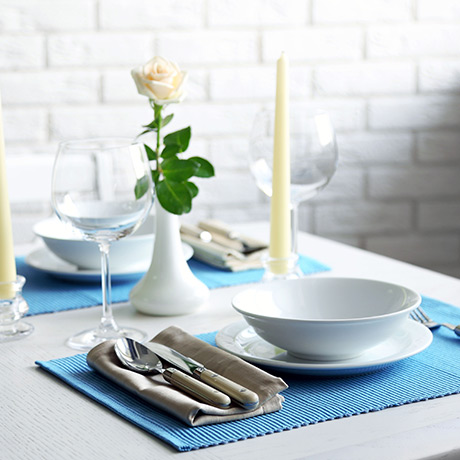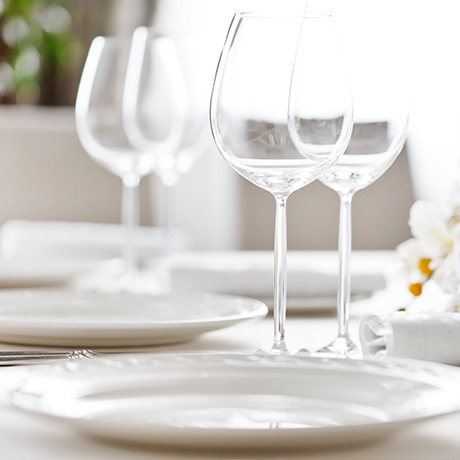The Art of Setting the Table

Hosting a dinner party for family and friends is one of life’s delights. Throwing a successful gathering is as much about the table setting as the food; it’s the stage on which you entertain and sets the mood for the evening.
Follow these simple tips for an impeccably dressed table, whether it is for a casual dinner or an elaborate gourmet meal.
Essentials for every occasion
Entertaining is a pleasure that should not be spoiled by a rigid adherence to rules or by a disregard for details. These tips will help guide you to create the ideal setting for your occasion.
Tablecloth
Start with a felt pad to protect the table; it helps to muffle the clatter of dishes and cutlery and will make guests more comfortable. Cover the pad with a tablecloth suited to both the dinnerware and type of dinner. The tablecloth should hang down at least 20 cm on all sides.
Coloured and patterned tablecloths are popular, but white tablecloths are best for gourmet meals because they do not distract from the food presentation — some colours may go well together, while others may clash and affect sense of taste. If you have a beautiful table made from glass, marble or wood, you can use place mats instead.
Dinnerware
Generally, each setting is anchored by a large presentation plate or underplate. Underplates are not simply decorative; they protect the table from hot plates or bowls and ensure that the table does not appear empty between courses. The underplate remains in place for several starter courses, however, it can be removed when the entrée is served.
The salad plate goes on the right and the bread plate above on the left. Bread plates help keep the tablecloth free of crumbs and add a touch of elegance. Setting a roll on a napkin is also acceptable.
Dessert plates can be kept on a buffet or in the kitchen, until ready for use. Before serving dessert, discretely clear away dirty dishes from the table first. Make sure to place the appropriate cutlery and cups for coffee or tea, along with dessert.
Cutlery
Remember to polish the cutlery before use. Cutlery should be presented in the order it will be used, starting from the farthest from the plate to the closest. Place them 2 cm apart and align them 2 cm from the edge of the table, but be mindful of the comfort of your guests. Try to leave at least 60 cm between place settings on the same side of the table, and 80 cm for those facing each other.
The knife and spoon (if serving soup), are on the right side of the plate. The cutting edge of the knife should face inward toward the plate. Forks are on the left. The appetizer fork should be on the outside, to the left of the dinner fork.
You may want to limit yourself to three pieces of cutlery on each side of the plate. You can bring extra cutlery for the cheese, dessert and coffee when they are needed. Forks and spoons can be placed facing down (French style) or up (English style).
Glasses
Glasses are chosen according to the wine you'll be serving. Make sure to set water glasses for each guest, as well. Glasses should be placed above the plate.
Napkins
Napkins should match the tablecloth, or solid-coloured napkins may be used if they go well with the dinnerware.
Avoid complicated napkin folds that may garner compliments but are unnecessarily time-consuming. Simple, traditional techniques are best. Napkins, folded into a simple rectangle or triangle, should be place in the centre of the plates. If the plates have a lovely pattern, the napkins are simply folded in three and placed on the left. Avoid fancifully twisted napkins in glasses. This kind of arrangement belongs in restaurants.
Paper napkins that go well with the cloth napkins are perfectly appropriate when the meal includes seafood, such as lobster or other crustaceans, that have to be broken apart with one’s fingers.

Accessories make a difference

Flowers
Decorating the table with flowers adds a nice touch, but choose them carefully — the scent of some flowers might clash with the wine or a certain dish.
Be mindful of the size of your floral arrangements; large arrangements can block guests’ views and force them to twist and bend in order to see and converse with one another. A medium centrepiece or small individual bouquets above and to the right of each setting are preferable.
Candlelight
Using floating candles, candelabras, or candlesticks made from crystal, porcelain, pewter or silver can make a well-appointed table even more attractive and create a charming, intimate ambience.
Choose candles that complement the colour of the tablecloth, dinnerware and flowers. Make sure the placement of the candles has enough space or height as to not bother the guests facing them. Adjust the lighting in the dining room. Too high, it will overpower the candlelight; too dim, it will leave your guests struggling to see in the dark.
Lastly, if you are hosting more than six guests, remember to double the number of salt shakers, pepper shakers and any other extras you may need for a comfortable dining experience.













